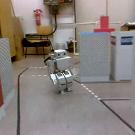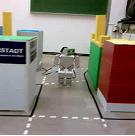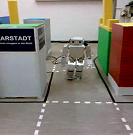Humanoid Robot Motion Planning
Autonomous robot navigation is becoming an increasingly important research topic for mobile robots. In the last few years, significant progress has been made towards stable robotic bipedal walking. This is creating an increased research interest in developing autonomous navigation strategies which are tailored specifically to humanoid robots. Efficient approaches to perception and motion planning, which are suited to the unique characteristics of biped humanoid robots and their typical operating environments, are receiving special interest. We are implementing a time-efficient motion planning system for a Fujitsu HOAP-2 humanoid robot. The sampling based algorithm is used to sample the robot route into segments and provide the robot with minimal free configuration space. For collision detection, the cylinder model to approximate the trajectory for the body-center of a humanoid robot is computed by approximating its shape by using one cylinder surrounding its body. A* search is used to find smooth and low-cost footstep placements of the humanoid robot within the resulted configuration space. .(for more details).
 |
 |
 |
 |

